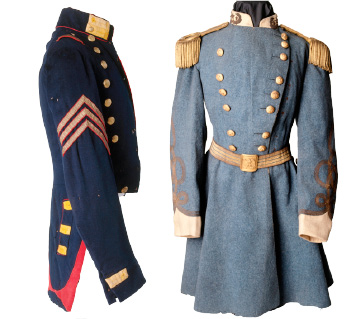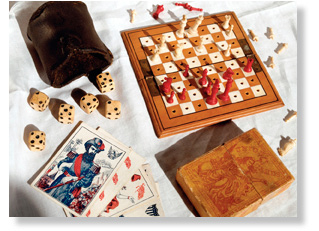Living History

The three stripes on this Confederate uniform indicate it belonged to a sergeant (left). The uniform on the right belonged to Pierre Beauregard, the Confederate general who led the attack on Fort Sumter.
There are children all over the country who take part in Civil War reenactments and living history weekends with their families. These events are held all over America: on farms, at living history museums, and in town squares. Some reenactments commemorate certain battles or events of the Civil War. Others are designed so spectators can experience a part of the Civil War and learn about the people who lived during the 1860s. Such events may involve just a few people, or as many as several thousand people.
True to History
Known as reenactors, these children (and adults) do their best to be true to all aspects of Civil War times. Reenactors try to look and act exactly as people would have in the 1860s. All their clothing must be of Civil War–period style and made of all-natural fabrics. Everything they use must have been available in the 1860s. At reenactments, sutlers sell clothes and equipment appropriate to the period.
At these events, reenactors do particular impressions, pretending to be certain kinds of people. There are two kinds of impressions: military and civilian. A few children are musicians trained to play the military tunes of the time. Almost all children do civilian impressions—they represent the life of the average child who lived during the 1860s.

Soldiers passed the time in camp with games of checkers, cards, and dice.
Battles, Chores, and Games
Civilian children have much to do at reenactments. There are battles to watch, sutler stores at which to shop, and even school to attend. Civil War families set up their canvas tents in a civilian camp, away from the military camp.
In a civilian camp, children reenact 1860s chores. They gather wood and help cook the family meals over an open fire. Sometimes, they pick fruit from nearby orchards or berries from the woods for special treats. Children fetch water for drinking and washing. They help clean up after meals and even wash their clothes by hand!
One of the best things about reenacting is playing the many games from the time period. Games using imagination—such as charades, guessing games, and riddles—were very popular. Contests and races of all kinds also were enjoyed, as children spent a lot of time outdoors playing with what nature provided. Music, too, was very important to children. Many played instruments and sang for enjoyment.
The Civil War was not just about battles. Children who reenact give others a broader view of the history of the 1860s. When spectators see children at a reenactment holding a fair to raise money for invalid soldiers or sewing handkerchiefs for a father who is away at battle, they are learning through living history. These young teachers and historians give us a glimpse of what it was like to live during the Civil War years.